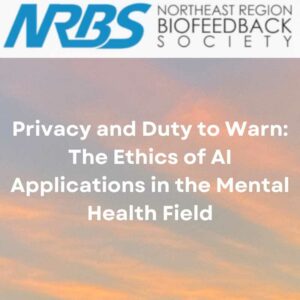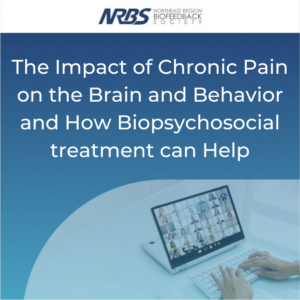CE #2 Havening Techniques for Biofeedback Clinicians
$45.00
April 24th, 2024 @12-1pm ET This program explore the history, methodology, and clinical applications of Havening Techniques alongside other psychosensory and sensorimotor methods. This session aims to enhance understanding of psychophysiological modulation through EEG, HRV, GSR, EMG, temperature assessments, and their implications on electrophysiology. We will examine neuroanatomy, neurotransmitters, hormones, and their relevance to Havening, emphasizing the importance of informed consent, meticulous history taking, and the clinician’s mindfulness.


Havening Techniques for Biofeedback Clinicians
Presented by Alexandra Linardakis, RN, BCN and Mitchell M. Sadar, PhD, BCN, BCB-HRV
🎙️ Listen to Healthy Brain Healthy Body Podcast FREE episode with Alexandra Linardakis
The program will describe the history and intent of Havening along with other psychosensory and sensorimotor techniques that have modulated psychophysiology in a meaningful way. Specifically we will address EEG, HRV, GSR, EMG, and temperature. We will address the impact of these techniques on electrophysiology as well as the clinician's understanding of the signals to help the clinician choose well for who may benefit and who may not with the technique. We will also address neuroanatomy, neurotransmitters, and hormones as they relate to some of the key components of Havening. We will cover the consent, history taking and clinician’s own state of being and how these are all relevant in utilizing this technique. In hearing Havening describe, the participants may find that there are clients of theirs that come to mind. The client’s tendencies and somatic behaviors will be elicited for consideration of their appropriateness for this technique.
Learning Objectives:
As a result of participating, the attendee will be able to:
Define psychosensory techniques broadly and specifically in terms of what makes HAVENING unique.
- describe encoding memories in the context of when all of the following four components are present: event/meaning/landscape/inescapability/ are all present
- Identify clients who may AND MAY NOT be good candidates for HAVENING=practitioner and client.
Diversity Statement:
In respecting and attending to the bodies of individuals, which is what Havening does; we include all bodies. Havening has the potential not to bypass the body itself and to let it speak. With Havening, people can tell their story, or they can focus on sensation. Havening allows the practitioner to facilitate the experience as a gracious host would, while the client is in charge and in control. Havening implies a fiduciary/trusting relationship. As this is client-centered, it is intended to be empowering. The client is told they can let the facilitator know if they are not connecting to a suggestion or anything at all that they need to be different for the Havening session. This puts the client in a ‘power with’ dynamic with the clinician. Historically, a common missing intervention with a trauma history is not being protected as one would expect. Empowering a story or sensation with the experience of safety, allows for a diversity of expression, depending on the person. The incremental and manageable steps towards one’s own sense of safety, understanding, and liberation will be facilitated one person at a time with Havening.
Presenter’s 1 Biography
Alexandra Linardakis, RN, BCN is the Principal Practitioner at TetraLexRN. Having founded the company in 2014, Alexandra works to clarify, simplify, and better the lives of her patients
Presenter’s 2 Biography
Mitchell Sadar is a licensed psychologist who was the director of a Pennsylvania Correctional Institution's inpatient program for over 15 years. In 1999 he was trained in neurofeedback and tried to bring this modality to the correctional population, but the Department of Corrections did not accept his attempts. He then resolved to dedicate his work to biofeedback and developed his private practice. Since 2015 he has been the president of the Northeast Region Biofeedback Society. His background in neuropsychology readily lent itself to learning how the EEG can facilitate neurofeedback training. In 2018, along with his practitioner wife, Angelika Sadar, he was invited to be part of BrainARC Switzerland and began developing evaluations and protocols based on the research of HBImed, Switzerland. Since that time, he has focused on developing assessments that include an analysis of EEG and ERPs to help to guide biofeedback/neurofeedback protocols but also include recommendations regarding psychotherapy and lifestyle changes.




